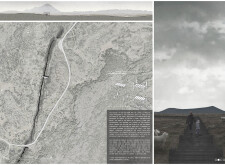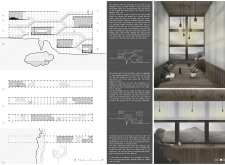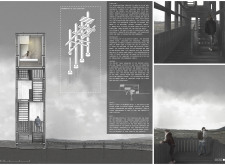5 key facts about this project
At its core, this project represents a commitment to enhancing community interaction and engagement. The design serves a dual purpose of providing essential services while creating a social hub that encourages connection among users. By integrating public spaces within the architecture, the project not only serves its primary function but also enriches the lives of those who inhabit and visit the space. The layout is intuitive, with carefully organized zones that facilitate both privacy and accessibility, meeting diverse user needs.
Key architectural elements include spacious, well-lit interiors that utilize natural light to create a welcoming atmosphere. Large windows and strategically placed openings provide a visual link to the outdoors, blurring the boundaries between internal and external environments. This design choice not only enhances aesthetic appeal but also promotes a sense of well-being through the use of natural materials and thoughtful landscaping.
The project incorporates a variety of materials that complement its architectural vision. The use of reinforced concrete forms the backbone of the structure, providing durability and structural integrity. Glass is extensively used in the façade, offering transparency that invites the outside in, while wood accents add warmth and texture to various surfaces. Steel elements are employed to highlight key design features, enhancing both stability and visual interest. The careful selection of these materials reflects not only an aesthetic choice but also a commitment to sustainability, with a focus on minimizing environmental impact through responsible sourcing and construction practices.
Unique design approaches are evident throughout the project. The architects prioritize sustainability by integrating features like green roofs and rainwater collection systems that enhance environmental performance. These elements are not merely functional but are artistically integrated into the design, creating a cohesive architectural narrative. Additionally, the incorporation of adaptive reuse strategies—repurposing existing structures—demonstrates a respect for the site’s history and contributes to a sense of continuity within the community.
Intriguingly, art plays a significant role in this architectural endeavor. Collaborations with local artists have resulted in installations that not only enhance the visual character of the project but also reflect cultural narratives relevant to the community. These artistic expressions help to further humanize the architecture, making it relatable and engaging for users.
As one delves deeper into the architectural plans, sections, and designs of this project, a clearer understanding of the underlying ideas and intentionality emerges. Each decision, from the spatial arrangement to the choice of materials, has been made with a focus on creating a functional yet beautiful environment. The project serves as a model of how architecture can respond thoughtfully to its context, social responsibilities, and environmental imperatives.
For those interested in exploring the intricacies of this project, I encourage a closer examination of its architectural plans, sections, and overall design strategies. These details provide valuable insights into the artistic and functional considerations that define this remarkable architectural endeavor.


























